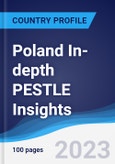This PESTLE country analysis report on Poland provides a holistic view of the country, with insightful analysis of current and future issues, supplemented with relevant quantitative data to support trend analysis.
Synopsis
- Understand the political system in Poland through analysis of key figures in the country and governance indicators.
- Understand the economic situation in Poland through a balanced assessment of core macroeconomic issues.
- Understand customer demographics in Poland through analysis of income distribution and the rural-urban split, as well as healthcare and education.
- Understand the technological landscape in Poland through analysis of relevant laws and policies, as well as patents data.
- Understand the legal landscape in Poland through analysis of the judicial system as well as performance of the legal indicators
- Understand the environmental landscape in Poland through analysis of the environmental regulations and the performance of the environmental indicators
Scope
- The political landscape section discusses the evolution of the political scenario in Poland, as well as the country's economic, social, foreign, and defense policies. The section also discusses the country's performance according to World Bank Governance Indicators.
- The economic landscape section outlines the evolution of Poland 's economy, as well as the country's performance in terms of GDP growth, composition by sector (agriculture, industry, and services), fiscal situation, international investment position, monetary situation, credit disbursement, banking sector, and employment."
- The social landscape section analyzes the government's social welfare policies, as well as the country's performance in terms of healthcare, income distribution, and education.
Reasons to Buy
- What is the outlook in Poland in terms of political stability, policies towards business, and the popularity of the government?
- How does Poland perform in terms of GDP growth, its fiscal situation, international investment position, monetary situation, and employment?
- How does Poland perform in terms of healthcare, income distribution, and education?
- How does Poland perform in terms of technology-intensive sectors like IT, life sciences, and R&D expenditure trends?
Table of Contents
- Overview
- Catalyst
- Summary
- Key findings
- PESTLE highlights
- Key macroeconomic updates
- Key economic updates
- Key fundamentals
- Key Facts and Geographic Location
- Key facts
- Geographic location
- PESTLE Analysis
- Summary
- Political analysis
- Overview
- Current strengths
- Current challenges
- Future prospects
- Future risks
- Economic analysis
- Overview
- Current strengths
- Current challenges
- Future prospects
- Future risks
- Social analysis
- Overview
- Current strengths
- Current challenges
- Future prospects
- Educational reforms
- Future risks
- Technological analysis
- Overview
- Current strengths
- Current challenges
- Future prospects
- Future risks
- Legal analysis
- Overview
- Current strengths
- Current challenges
- Future prospects
- Future risks
- Environmental analysis
- Overview
- Current strengths
- Current challenges
- Future prospects
- Future risks
- Political Landscape
- Summary
- Evolution
- Structure and policies
- Key political figures
- Composition of government
- Key policies
- Performance
- Governance indicators
- Outlook
- Economic Landscape
- Summary
- Evolution
- Structure and policies
- Financial authorities and regulators
- Performance
- GDP and GDP growth rate
- GDP composition by sector
- Agriculture
- Industry
- Fiscal situation
- International trade
- Government debt
- Current account
- International investment position
- Monetary situation
- Employment
- Outlook
- Social Landscape
- Summary
- Evolution
- Structure and policies
- Demographic composition
- Healthcare
- Education
- Performance
- Healthcare
- Education
- Outlook
- Technological Landscape
- Summary
- Evolution
- Structure and policies
- Intellectual property
- Performance
- Mobile and internet users
- Outlook
- Legal Landscape
- Summary
- Evolution
- Structure and policies
- Judicial system
- Tax regulations
- Performance
- Effectiveness of legal system
- Outlook
- Environmental Landscape
- Summary
- Evolution
- Structure and policies
- Performance
- Environmental impact
- Outlook
- About the Publisher
- Contact the Publisher
List of Tables
Table 1: Key fundamentals, 2021-28f
Table 2: Key facts, 2024
Table 3: Analysis of political landscape
Table 4: Analysis of economic landscape
Table 5: Analysis of social landscape
Table 6: Analysis of technological landscape
Table 7: Analysis of legal landscape
Table 8: Analysis of environmental landscape
Table 9: Population by gender (as a percentage of total population), 2023
List of Figures
Figure 1: Key economic indicators trend
Figure 2: Map of Poland, 2024
Figure 3: Labor productivity in terms of GDP per hour worked ($), 2023 or latest available data
Figure 4: Poland’s export destinations share as % of total exports, 2023
Figure 5: Social benefits to households in kind, 2023 or latest available data
Figure 6: Female labor force participation rate, 2022
Figure 7: Public spending on labor markets as a percentage of GDP, 2021
Figure 8: Old-age dependency ratio, 2050
Figure 9: Tertiary graduates in engineering, 2021
Figure 10: High-technology exports (percentage of manufactured exports), 2022
Figure 11: Tax wedge across OECD nations, 2023
Figure 12: Municipal waste generation, 2022 or latest data available
Figure 13: Share of energy from renewable sources, 2022
Figure 14: Timeline of key political events
Figure 15: Key political figures
Figure 16: Composition of the Sejm (lower house of parliament), October 2023
Figure 17: Historical GDP growth rate, 2013-23
Figure 18: Real GDP and GDP growth rate, 2019-28f
Figure 19: GDP composition by sector, 2023
Figure 20: Agricultural output, 2019-24f
Figure 21: Industrial output, 2019-24f
Figure 22: Services output, 2019-24f
Figure 23: Growth in the volume of exports and imports, 2019-28f
Figure 24: Consumer price index and inflation rate, 2019-28f
Figure 25: Unemployment rate, 2019-28f
Figure 26: Major religions, 2022 est.
Figure 27: Government expenditure on healthcare, 2019-28f
Figure 28: Government expenditure on education, 2019-28f
Figure 29: Internet users, 2019-24f
Figure 30: CO2 emissions, 2012-22








